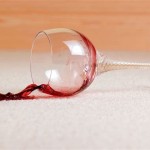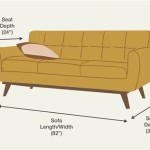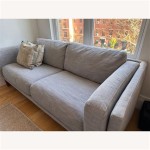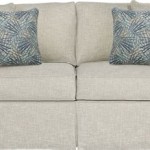Cat-Proofing Sofa Beds: Protecting Your Furniture from Feline Fervor
Sofa beds offer dual functionality, providing seating and a sleep solution in a single piece of furniture. However, for cat owners, they often present a battleground in the ongoing war against scratches, stains, and general feline destruction. Protecting a sofa bed from the relentless attention of a cat requires a strategic approach, considering both the cat's natural behaviors and the vulnerabilities of the furniture itself.
This article examines practical and effective methods for cat-proofing sofa beds, aiming to minimize damage and maintain the furniture's aesthetic appeal and longevity. The discussed strategies encompass material selection, physical barriers, deterrents, and redirecting feline behavior toward more appropriate outlets.
Choosing the Right Materials: A First Line of Defense
The fabric of a sofa bed is its primary defense against cat claws. Certain materials are inherently more resistant to scratching and snagging than others. When purchasing a new sofa bed or reupholstering an existing one, opting for cat-friendly fabrics can significantly reduce the severity of damage.
Microfiber, particularly tightly woven varieties, is often recommended for its durability and resistance to scratching. The close weave makes it difficult for cats to penetrate the fabric with their claws, minimizing the likelihood of snags and pulls. Furthermore, microfiber is relatively easy to clean, making it a practical choice for households with pets prone to accidents or shedding.
Leather, especially treated or finished leather, can also be a viable option. The smooth surface offers little purchase for cat claws, discouraging scratching. However, it is important to note that while leather is generally durable, it can still be susceptible to scratches, particularly from determined cats. Regular conditioning can help maintain its integrity and minimize the visibility of any minor damage. Faux leather offers a similar aesthetic but may be less durable than genuine leather. Its resistance to scratching varies depending on its composition and weave.
Canvas and other tightly woven, durable fabrics can also withstand feline scratching. The tighter the weave, the more difficult it is for cats to snag their claws. However, the texture of some canvas fabrics may be attractive to certain cats, making them more likely to attempt to scratch it. Consider the individual cat's preferences when selecting a canvas-based fabric.
Materials to avoid include delicate fabrics such as silk, velvet, and loosely woven materials. These fabrics are easily snagged and torn, making them highly vulnerable to cat claws. Additionally, fabrics with prominent textures or loops, like bouclé, can be particularly enticing for cats to scratch.
Implementing Physical Barriers: Shielding Vulnerable Areas
Physical barriers offer another layer of protection, preventing cats from accessing specific areas of the sofa bed or discouraging them from scratching altogether. These barriers can range from simple coverings to more elaborate solutions designed to completely enclose susceptible areas.
Sofa covers, specifically designed to be cat-proof, provide a comprehensive shield against scratches, stains, and fur. These covers are typically made from durable, tightly woven fabrics and are available in various styles and sizes to fit different sofa bed models. Look for covers that are waterproof or water-resistant to further protect the sofa bed from accidents. Opt for covers that are easy to remove and wash for convenient cleaning.
Scratch guards, made from materials like clear plastic or sisal, can be applied to the sides and corners of the sofa bed, which are common scratching targets. These guards act as a physical barrier, preventing cats from accessing the underlying fabric. Clear plastic guards are discreet and blend in with the furniture, while sisal guards offer an alternative scratching surface.
Furniture protectors, such as blankets or throws, can be strategically placed over vulnerable areas of the sofa bed. While not as comprehensive as a full sofa cover, these protectors can effectively shield specific areas from scratching. Choose durable, washable materials for easy maintenance. Secure the blankets or throws to prevent them from shifting and exposing the underlying fabric.
Consider using a pet playpen to surround the sofa bed when it is not in use. This will prevent the cat from accessing the sofa at all. This is a more extreme measure, but can be taken when a cat is consistently damaging furniture. This method uses the cat’s curiosity and exploration to prevent the cat from damaging the furniture.
Deterrents and Redirecting Behavior: Shaping Feline Habits
Deterrents and behavior redirection strategies aim to discourage cats from scratching the sofa bed and encourage them to engage in more appropriate scratching activities. These methods rely on understanding feline behavior and providing alternative outlets for their natural instincts.
Commercial cat repellents, available in spray or wipe form, can be applied to the sofa bed to deter scratching. These repellents typically contain ingredients that cats find unpleasant, such as citrus or bitter apple. Always test the repellent on a small, inconspicuous area of the sofa bed first to ensure it does not cause discoloration or damage. Reapply the repellent regularly, as its effectiveness may diminish over time.
Double-sided tape can be applied to the areas of the sofa bed where the cat typically scratches. Cats dislike the sticky texture of the tape and will be discouraged from scratching those areas. Replace the tape as needed to maintain its stickiness. While generally safe for furniture, test the tape on a small area first to ensure it does not damage the fabric.
Provide alternative scratching posts or mats near the sofa bed. These scratching posts should be made of materials that cats find appealing, such as sisal, cardboard, or carpet. Experiment with different types of scratching posts to determine which ones the cat prefers. Place the scratching posts in prominent locations, such as near the sofa bed or in areas where the cat spends a lot of time. Encourage the cat to use the scratching posts by rubbing catnip on them or rewarding them with treats when they scratch them.
Regular nail trimming can significantly reduce the damage caused by cat scratching. Trim the cat's nails every two to three weeks to dull the tips and minimize their ability to snag on the fabric. If you are uncomfortable trimming the cat's nails yourself, consult with a veterinarian or groomer.
Positive reinforcement can be used to reward the cat for scratching appropriate surfaces and discourage them scratching inappropriate surfaces. When the cat scratches the scratching post or mat, offer praise, petting or a treat. If the cat scratches the furniture, redirect them to the scratching post and reward them when they use it.
Enrich the cat's environment with toys, climbing structures, and interactive games to provide mental and physical stimulation. A bored cat is more likely to engage in destructive behaviors, such as scratching furniture. Providing plenty of opportunities for play and exercise can help reduce their motivation to scratch the sofa bed.
Consider adding multiple cat trees, especially if your cat likes to scratch in an elevated position. This will give the cat an approved place to scratch that is not your sofa bed. Ensuring the cat tree is strong and sturdy is important. Otherwise, the cat may not be able to properly scratch on it.
If dealing with destructive cat scratching behaviors, consider consulting with a veterinarian or a certified cat behaviorist. These professionals can assess the cat's behavior and provide tailored recommendations for addressing the underlying causes of the scratching. Certain medical conditions or anxiety issues can contribute to destructive scratching behaviors. A professional can help differentiate between normal scratching habits and potential underlying issues. They may also be able to prescribe medication or recommend specific behavior modification techniques.
By understanding the cat's natural behaviors and implementing a combination of these strategies, it is often possible to minimize damage to sofa beds and other furniture, creating a harmonious living environment for both humans and their feline companions. Choosing the right materials, implementing physical barriers, and actively redirecting scratching behavior are all crucial components of an effective cat-proofing strategy.

Cat Proof Scratch Resistant Sofas Home Atelier

Cat Proof Scratch Resistant Sofas Home Atelier

8 Tips To Cat Proof Your Sofa

6 Best Cat Proof Couches That Actually Stand Up To Scratching 2024

Length 200cm Raffael Designer Electric Motorised Extendable Sofa Bed Available In High Quality Cat Proof Scratch Resistant Suede Fabric Material Sb7157 Furniture Home Living Sofas On Carou

Finding The Perfect Kid Proof Cat Life Couch Sneakers Lipstick

Length 133cm Torres Sofa Bed Available In High Quality Cat Proof Scratch Resistant Corduroy Velvet Fabric Material Sb9166 Furniture Home Living Sofas On Carou

Cecil Tufted Pull Out Scratch Resistant Sofa Bed Home Atelier

Waterproof Blanket For Dogs Urine Liquid Proof Couch Sofa Bed Soft Reversible Furniture Protector Cover Sherpa Pet Small Medium Large Dog Cat 80x60 Inches Com

Length 100cm Sasha Electric Sofa Bed Available In High Quality Cat Proof Scratch Resistant Leather Aire Material Sb7155 Furniture Home Living Sofas On Carou








